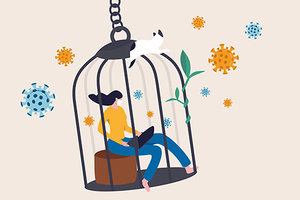For months, the media has scared the public so well, it's going to be a while until they truly venture out freely again, even though "stay-at-home" restrictions have eased in many places as I write this article in early June. The best we can do as doctors is understand what the public and your patients are going through, and be available when they are ready to start care.
Feelings are real things. They're not "just feelings." Ignore them at your peril! The emotions we've all endured in the past few months are justified. I'll suggest some remedies and provide a story that illustrates how these psychological states influence our actions.
 The story is the story of our times. We've been through a lot lately. At the end of this emotional rollercoaster is hope. Most of us are probably just starting to get there, but it's the fifth and final stage of "lockdown."
The story is the story of our times. We've been through a lot lately. At the end of this emotional rollercoaster is hope. Most of us are probably just starting to get there, but it's the fifth and final stage of "lockdown."
You may not have gone through these stages in any particular order. You might be stuck in one phase, or even revisit previous stages ... because you're human, too.
Stage 1: Disbelief
It's been unbelievable what's been happening since 2020 began. You may have found some of the things our leaders said during this time, and continue to say, incredible. Your world has been turned upside down. Maybe your clinic was closed by the state and you never dreamed that could happen. Maybe you're still not operating at full capacity.
Stage 2: Anger
Perhaps you're angry about it. Have you noticed people seem irritable? They've been running red lights, yelling at each other in the street to "wear a mask" or saying things like "this is a pandemic, not a party." Maybe you're annoyed that business was – or still is – down? Perhaps you're upset that everyone got bailed out but you?
Stage 3: Sadness
You may have found yourself sobbing. You may still be upset at the loss of structure in your life. Everything changed so suddenly.
A COVID Story
This story illustrates the emotions of the first three stages. A 5-year-old named Noah was raised by his grandmother. But his family had been practicing social distancing, and it had been some time since he'd seen her. Noah's father said: "Grandma's coming, but don't get too close; you could make her sick."
The boy didn't believe it. By the time grandma rang the doorbell, he forgot the conversation. He rushed to the door and hugged his grandmother's knees. His daddy shouted, "Didn't I tell you not to get too close to grandma?"
His father was in phase 2: anger. The boy was in disbelief and sank quickly in to stage 3: sadness. He started to cry and grandma started to cry. Finally, the boy said, "I'm going to go upstairs, take a hot bath, and put on my pajamas." He never did that in the afternoon.
You might recognize that you're still in one of these states, or that you recently were: disbelief, anger or sadness. Or, you could be in Phase 4: Acceptance, especially if you're using phrases like "the new normal." Perhaps you like this "new normal" and have given up on the rat race. You're enjoying your life now; spending more time with your family and looking forward to more of this opportunity in your life.
Be patient with yourself and this process we're all going through. Be sure to do the same things you're telling your patients to do. Get lots of rest. Enjoy brisk exercise. Drink lots of water. Avoid drugs. Pray, meditate and certainly talk about these feelings with someone. And of course, get adjusted.
Stage: 5 Optimism – The Final Stage
It's time to start dreaming again! Don't settle for "normal." Look forward to a better life, a positive change for humanity. Anticipate peace, forgiveness, kindness toward one another. Perhaps you want more connectedness, family, friends, happiness, gratitude and laughter. All of this is within your reach and awaits you at the end of this crazy detour we've been through.
Every morning and again before you sleep, see yourself reflecting healing light onto your community. Envision crowds coming to your clinic, the tables filled. See people leaving elated and restored. Imagine it again and again. Most of all, see yourself delighted with your practice thriving.
Fear Versus Faith
We've been bludgeoned by the media on a daily basis with a message of fear. We sat for months watching the body count rise, listening to scientists, doctors and politicians repeat the "stay home" mantra.
People are hungry for hope. They want to know how diet, exercise, rest and chiropractic adjustments can enhance their resistance to disease. There is a pent-up demand for ways to stay well naturally and you're ideally positioned to help families build immunological competency. They are ready to learn that they don't have to depend on face masks and hand sanitizer to be healthy; that they don't have to live in fear anymore.
Dr. Steven Visentin, a 1982 graduate of National College of Chiropractic, is a solo practitioner and clinic director at Care Chiropractic in Denver. He is also the author of an e-book, Blow Your Head Off Practice Building Secrets. For additional information, contact Dr. Visentin via his Web site, www.carechiropractic.com.




